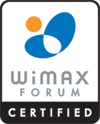
Adaptive Coding and Modulation
The Aperto® system has the ability to dynamically adapt modulation and coding levels as a function of the link between the base station and each subscriber unit. Hence at any point in time, each subscriber may have a different set of values for these parameters, which may independently evolve over time, as link conditions change. The Aperto system allows flexibility in the following set of link parameters:
- Dynamic Modulation: The system adaptively switches between QPSK and 16QAM modulation. Dynamic modulation allows the link margin to increase by 7-8 dB, thus leading to the following benefits:
-Dynamic modulation extends the radius of coverage of the cell, so that subscribers that are closer to the base station receive 16QAM reception, while those further away receive QPSK.
-Dynamic modulation increases robustness against co-channel interference, thus enabling more aggressive frequency re-use plans and smaller cell sizes.
-Dynamic modulation helps to enable reception in OLOS/NLOS cases, by enabling the link to function with lower received power. - Dynamic Coding: The system adaptively switches between two levels of Forward Error Correction (FEC) coding capabilities. Dynamic coding allows the link margin to increase by about 2-3 dB, and leads to the same set of benefits as listed for dynamic modulation. Since dynamic coding leads to a smaller decrease in link speed, it is used as the first line of defense against link impairments, before dynamic modulation kicks in.
The different modulation and coding levels can be arranged in the following order of increasing robustness:
1. 16QAM, Low FEC
2. 16QAM, High FEC
3. QPSK, Low FEC
4. QPSK, High FEC
Figure 1 plots the normalized TCP throughput as a function of SNR, for each of the four combinations enumerated above. Level 1 has the highest throughput, but also is the first to fall in performance, as SNR decreases. Conversely, Level 4 has the lowest throughput, but is able to survive the longest as the SNR is decreased. A system that does not have adaptation will be forced to operate in one of these two extreme states:
- If set to Level 1, it will have limited coverage, but will serve those that it can reach, with the best throughput,
- If set to Level 4, it will have the best coverage, but half the bandwidth will be un-available
Adaptive coding and modulation helps to capture the best of both worlds, since the system is able to supply Level 1 to all subscriber units that have a good link to the base station, and Levels 2 and higher to subscriber units whose link is not as good. Hence the service provider is able to maximize his coverage, while making optimum use of the available bandwidth. This is illustrated in Figure 2, in which the thick line shows the response of the system as the SNR is changed. The system is able to optimally jump from one level to another as the SNR changes, and thus closely track the upper envelope of the individual throughput curves.
Figure 1: TCP Throughput versus SNR for Static Modulation and Coding
Figure 2: TCP Throughput versus SNR for Adaptive Modulation and Coding


